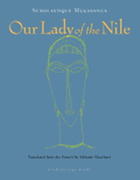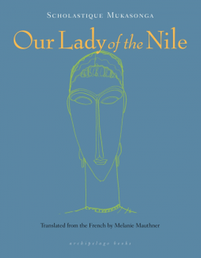
 Scholastique Mukasonga's entertaining first novel about a girls' school in Rwanda in the early '90s is far more than just a prelude to the coming bloodbath. Our Lady of the Nile is written with the glee of storytelling and plenty of humor, depicting the dire Rwandan conflict through some very likable teenagers. The titular Our Lady of the Nile is a four-story lycée located close to the source of the Nile River, presided over by the black Madonna, a statue of the Virgin Mary that's been repainted. The isolated, high-altitude school was built in 1953, about a decade before Rwanda gained independence from Belgium. There, the students remain virgins--or, at least, avoid getting pregnant.
Scholastique Mukasonga's entertaining first novel about a girls' school in Rwanda in the early '90s is far more than just a prelude to the coming bloodbath. Our Lady of the Nile is written with the glee of storytelling and plenty of humor, depicting the dire Rwandan conflict through some very likable teenagers. The titular Our Lady of the Nile is a four-story lycée located close to the source of the Nile River, presided over by the black Madonna, a statue of the Virgin Mary that's been repainted. The isolated, high-altitude school was built in 1953, about a decade before Rwanda gained independence from Belgium. There, the students remain virgins--or, at least, avoid getting pregnant.
The novel is a series of interrelated stories featuring a different girl in each chapter, with the same recurring ensemble of students throughout. Most dangerous is Gloriosa, a militant Hutu student prone to persuasive stump speeches, who pries into everyone's business as the watchful eye of the powerful Hutu Party. Gloriosa decides to erase any Tutsi features of the black Madonna by breaking off the statue's nose in the night and reshaping out of clay a "true Rwandan majority" nose. Godelive gets the worst grades, but has mysteriously posted a full-length portrait of the Belgian royalty in her alcove and keeps her suitcase under the bed, padlocked. Immaculée arrives on her boyfriend's motorbike, and seeks out an ancient woman who talks to the rain for a love spell to make him faithful.
Next door to the school is the neglected coffee plantation of Fontenaille, the crazy, solitary European who organizes digs for bones and is notorious for sketching the girls. Convinced that the Tutsi are descended from the empire of the black pharaohs, he tells Veronica, the most beautiful student, and her best friend, Virginia, that they are the return of Isis and Candace. When he shows them the Egyptian temple in his garden built over the bones of an ancient queen, the awakened regent's spirit begins to seek refuge in Virginia's dreams.
Sometimes the school itself is the source of conflict. Girls at the lycée are not allowed to speak Swahili, the language of Muhammad. They are forced to eat white people's food, which usually comes in cans. The treacherous chaplain who heads the Catholic Relief Services reserves the loveliest donated dresses for his favorite students; to receive the "gifts," the girls must undress in front of him.
Despite the serious setting, Mukasonga proves to be a playful author, and a chuckling good humor pervades the book. Her deliciously limpid, melodious style makes Rwandan daily life vividly accessible. Our Lady of the Nile offers a total immersion in a way of life--with its own customs and morality--through a handful of comical and compelling schoolgirls swept up in the divisive politics of a nation. Mukasonga expertly draws together all her threads and stories in the climactic sequences to create a skillfully orchestrated vision, both loving and fearful, of her beloved homeland ripped apart by vicious racial hatred. --Nick DiMartino, Nick's Picks, University Book Store, Seattle, Wash.
Shelf Talker: An isolated girls' school becomes the center of a frequently funny tale of teenage students caught in a nation's crisis, just before the Rwandan genocide in 1994.

